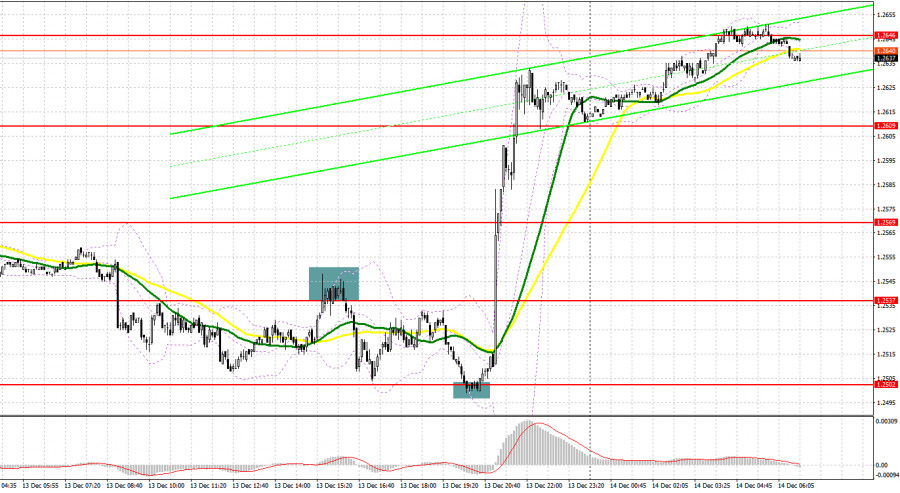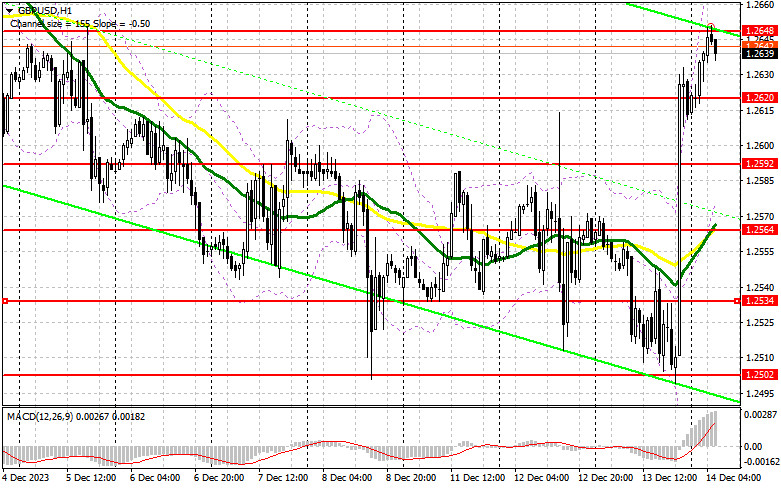
Yesterday, the pair formed several entry signals. Let's have a look at what happened on the 5-minute chart. In my morning review, I mentioned the level of 1.2533 as a possible entry point. A breakout and retest of 1.2533 after weak UK GDP data produced a sell signal, which sent the pair down by more than 25 pips. In the afternoon, a failed attempt to rise above 1.2537 generated a sell signal. As a result, the pound fell by 35 pips. Safeguarding the monthly low of 1.2502 and a false breakout produced a buy signal, which sent the pair up by more than 100 pips.

For long positions on GBP/USD:
Yesterday's gloomy UK data on GDP, industrial production and the balance of trade exerted pressure on the pound, but the Federal Reserve's pivot to cutting rates next year rectified the situation. If today, the Bank of England confirms its intentions to act more firmly, as has been repeatedly stated recently, big players will support the pound and the pair will continue to rise. Of course, in the current situation, we would like to get an entry signal on the pound's decline. A false breakout at 1.2620 would be an ideal signal to buy the pound in the first half of the day while aiming for 1.2648. A breakout and consolidation above this range will strengthen the demand for the pound and open the way to 1.2682. The furthest target will be the 1.2722 area, where I plan to take profits. If the pair falls and there is no buying activity at 1.2620, which will happen in case the BoE shows a soft stance, only a false breakout near the next support at 1.2592 will signal opening long positions. I plan to buy GBP/USD immediately on a rebound from 1.2564, aiming for an intraday correction of 30-35 pips.
For short positions on GBP/USD:
Sellers have a small chance of building a downtrend. Only soft rhetoric from the Bank of England will allow bears to return to the market. For this reason, you should be careful with short positions. Sellers will have to defend and form a false breakout near resistance at 1.2648. This will create a sell signal, which will give bears a chance to move the price down to the intermediate support at 1.2620, established yesterday. A breakout and a retest from below will deal a more serious blow to the bulls' positions, leading to the removal of stop orders and open the way to 1.2592, where the bulls will be active. The next target would be the 1.2564 area, where I will take profits. This is in line with the moving averages. If GBP/USD rises and there is no activity at 1.2648, I will postpone sales until the price performs a false breakout at 1.2682. If there is no activity there either, I recommend opening short positions on GBP/USD from 1.2722, anticipating a 30-35 pip downward rebound within the day.

COT report:
The Commitments of Traders (COT) report for December 5 showed a sharp increase in long positions and a decline in short ones. The pound is still in demand, as Bank of England Governor Andrew Bailey and other BoE policymakers mentioned that the interest rates will need to be kept at the current level, if not raise them. This led traders to believe that they can buy the pair on every good downward move. The Federal Reserve and the BoE meetings will be held this week, which will be decisive. The soft tone of the US central bank will weaken the dollar's positions. If the situation is reversed, and if the Fed says it needs to wait longer to decide when to cut interest rates, and the Bank of England starts worrying about the prospects for economic growth, then it is inevitable that the pound will fall. The latest COT report indicates that non-commercial long positions rose by 5,063 to 66,359, while non-commercial short positions were down by 14,497 to 54,694. As a result, the spread between long and short positions increased by 3,025.
Indicator signals:
Moving Averages
Trading above the 30- and 50-day moving averages indicates a possible uptrend.
Please note that the time period and levels of the moving averages are analyzed only for the H1 chart, which differs from the general definition of the classic daily moving averages on the D1 chart.
Bollinger Bands
If GBP/USD declines, the indicator's lower border near 1.2590 will serve as support.
Description of indicators:
• A moving average of a 50-day period determines the current trend by smoothing volatility and noise; marked in yellow on the chart;
• A moving average of a 30-day period determines the current trend by smoothing volatility and noise; marked in green on the chart;
• MACD Indicator (Moving Average Convergence/Divergence) Fast EMA with a 12-day period; Slow EMA with a 26-day period. SMA with a 9-day period;
• Bollinger Bands: 20-day period;
• Non-commercial traders are speculators such as individual traders, hedge funds, and large institutions who use the futures market for speculative purposes and meet certain requirements;
• Long non-commercial positions represent the total number of long positions opened by non-commercial traders;
• Short non-commercial positions represent the total number of short positions opened by non-commercial traders;
• The non-commercial net position is the difference between short and long positions of non-commercial traders.